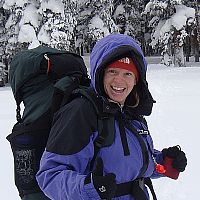Bunting et al., 2010
Estimating large-scale evapotranspiration in arid and semi-arid systems: A multi-site study linking MODIS and Ameriflux data.
Bunting, D.P., Glenn, E.P., Kurc, S.A., Scott, R.L., Nagler, P.L. (2010)
AGU Fall Meeting (Poster) Abstract H31B-1000.
-
Catalina-Jemez, INVESTIGATOR
Abstract
A common goal for water resource managers is to ensure long-term water sustainability for increasing human populations in the arid and semi-arid southwestern United States. In these areas, estimating evapotranspiration (ET) at watershed or river-reach scales is critical in determining an amount of water that can be apportioned for human needs (i.e. agriculture, municipal use) while still maintaining healthy riparian vegetation and wildlife. ET measurements are often made on local scales (< 1 km2) that may not represent an entire watershed. Larger watershed scale estimates are necessary in decision making, but scaling up ET is often problematic in semi-arid regions. This is in part because pulse-type precipitation, typical in these areas, leads to pronounced spatial and temporal variability in both moisture availability and vegetation green up. Traditional methods of scaling up ET often do not account for this variability (e.g. crop coefficients do not account for seasonal variability and have often led to gross overestimates of ET losses). Incorporating this temporal and spatial variability is critical for providing accurate estimates of ET losses. High-resolution satellite data is now available and provide spatially distributed remote sensing products (e.g. Normalized Difference Vegetation Index NDVI, Enhanced Vegetation Index EVI) that account for temporal and spatial variability in vegetation dynamics. These remote sensing products, in combination with micrometeorological data, can be used to create empirical models for improving ET estimates at larger scales. Using this approach, we estimated ET at five sites, chosen to represent a gradient in vegetation across the southwestern United States. We correlated Moderate Resolution Imaging Spectroradiometer (MODIS) EVI values to both MODIS nighttime surface temperatures (Ts) and flux tower ET. Our main objective is to use these strong relationships to create a unique empirical ET model for each vegetation type. Future research includes applying these empirical models to large river-reaches across the southwestern United States. Total annual ET can be estimated at river-reach or watershed scales provided that each region is classified appropriately and surface area is known. This approach is expected to improve accuracy of ET estimates at large scales.
Citation
Bunting, D.P., Glenn, E.P., Kurc, S.A., Scott, R.L., Nagler, P.L. (2010): Estimating large-scale evapotranspiration in arid and semi-arid systems: A multi-site study linking MODIS and Ameriflux data. AGU Fall Meeting (Poster) Abstract H31B-1000..
Explore Further

